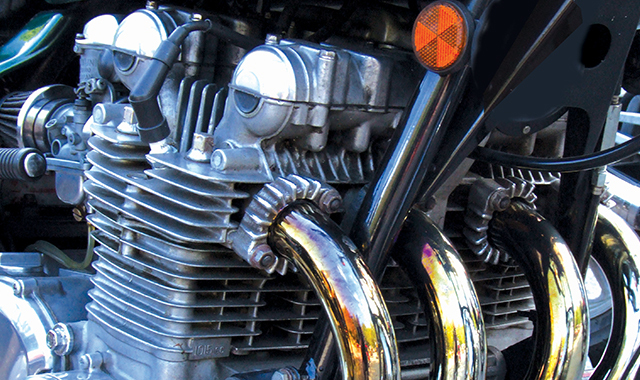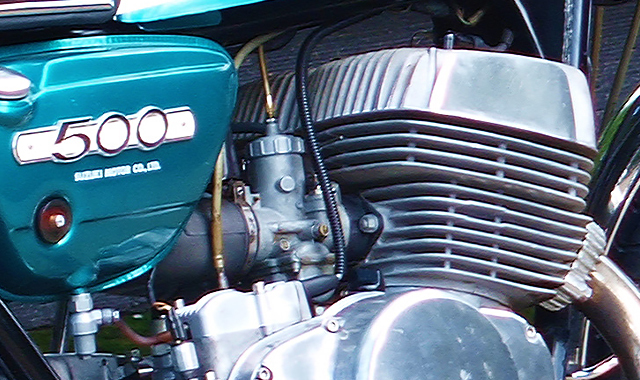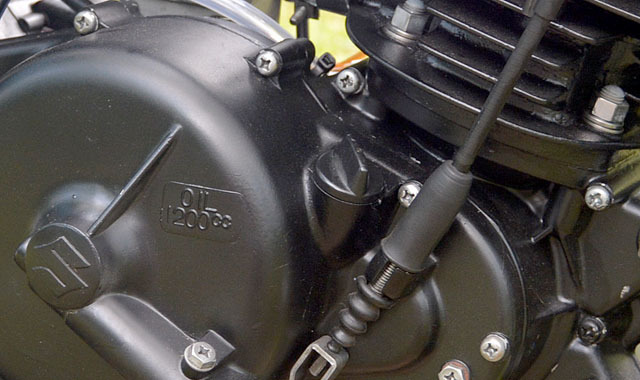See our Christmas opening times here

HOW TO CHECK:
BRAKES - COOLANT - LUBRICANTS - LIGHTS - STEERING - SUSPENSION - TRANSMISSION - TYRES
 It is important to check your engine oil level is correct on a regular basis to avoid any potential engine seizure, which could result in a costly repair - or possibly even a write off depending on the age of the motorcycle. Most bikes use either a dipstick or an oil level window located on one of the engine casings in order to allow you to see if topping up is required. Some other bikes, such as the first generation Aprilia RSV1000, have a very specific (not to say complicated) way to check the engine oil level, but we will not get into that today
It is important to check your engine oil level is correct on a regular basis to avoid any potential engine seizure, which could result in a costly repair - or possibly even a write off depending on the age of the motorcycle. Most bikes use either a dipstick or an oil level window located on one of the engine casings in order to allow you to see if topping up is required. Some other bikes, such as the first generation Aprilia RSV1000, have a very specific (not to say complicated) way to check the engine oil level, but we will not get into that today
Before checking the oil level, you can run the engine for a few minutes to liquify the oil, then let the bike rest for another few minutes to allow the oil to settle - however, if your bike has been sitting for a few hours, you shouldn't need to run the engine as the oil is not as thick as custard (if it is, you have a serious issue!) and would be mostly sit at the bottom of the engine already.
When checking the level, ensure the bike/engine is level and not on an incline or decline as this can give a false reading. Some riders favour having the bike on the centre stand when doing an oil check, however, this can also affect the level of the engine (when a bike is on the centre stand, you can clearly see one of the wheels is off the ground, indicating that the engine is not level). Ideally get a mate to hold the bike straight or, with a bit of practice, it becomes quite easy to hold the bike on its balancing point yourself while checking the oil level.
Both your dipstick and oil level window should show a Minimum and Maximum line, we would recommend that you aim to top up to slightly below the Max line. Remember that most of this information is in your bikes user manual and taking the time to read this daunting book can prove to be very beneficial! It will usually tell you which grade of oil to use.
 Unlike 4 stroke engines, good old 2 stroke engines use a separate oil for the top / crankshaft and for the gearbox.
For the bottom of the engine (gearbox), check your oil level on a regular basis using either a dipstick, located on the engine casing, the oil level screw cap or however the manufacturer recommends that you do it in the manual. Unlike 4 stroke engines, the gearbox oil is not used to lubricate the moving parts in the top end of the engine and does not get burned away, therefore, the level is not affected as much. However, still check it every 500 miles or so.
Unlike 4 stroke engines, good old 2 stroke engines use a separate oil for the top / crankshaft and for the gearbox.
For the bottom of the engine (gearbox), check your oil level on a regular basis using either a dipstick, located on the engine casing, the oil level screw cap or however the manufacturer recommends that you do it in the manual. Unlike 4 stroke engines, the gearbox oil is not used to lubricate the moving parts in the top end of the engine and does not get burned away, therefore, the level is not affected as much. However, still check it every 500 miles or so.
2 stroke oil is used for the lubrication of the top end. You will have a separate oil tank (Check the level every time you refuel, as the oil is being mixed by the oil pump with the petrol, allowing accurate lubrication of the piston / cylinder / crankshaft bearings / etc ) Or, if you've decided not to rely on the oil pump (because it has let you down too many times before!) you are now doing your own fuel / oil mixture at the % you feel is best for the bike. Which ever way you are going about it, do not forget the 2 stroke oil! Remember to check your user manual for information on which oils to use.
 More uncommon as transmission chain bikes, some bikes use a shaft instead of the traditional chain / sprockets or drive belt set up. The gearbox shaft oil level usually does not vary too much, however, it is good practice to check it every 500 or 1000 miles, just in case. There are many different viscosities of gearbox oils available, check your manual to find the correct one
More uncommon as transmission chain bikes, some bikes use a shaft instead of the traditional chain / sprockets or drive belt set up. The gearbox shaft oil level usually does not vary too much, however, it is good practice to check it every 500 or 1000 miles, just in case. There are many different viscosities of gearbox oils available, check your manual to find the correct one
Engine oil and gearbox oil should be changed either once a year, or at the manufacturer's recommended mileage which can be found in the manual. When replacing the oil, we would advise changing the oil filter, as they are usually very affordable. Always clean the oil strainer where applicable. Do not forget to change the sump plug washer / o-ring too while you're at it!
VIEW - 2 Stroke Engine Oil - Fully Synthetic - Mineral - Semi-Synthetic - Transmission Oils